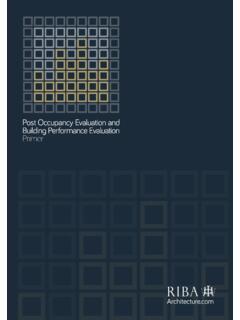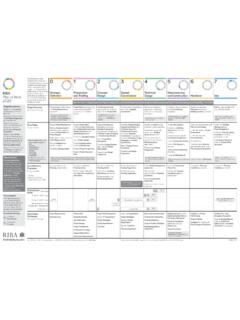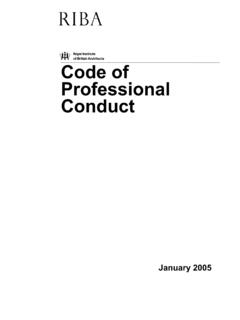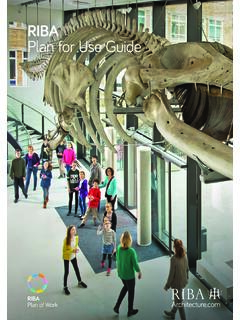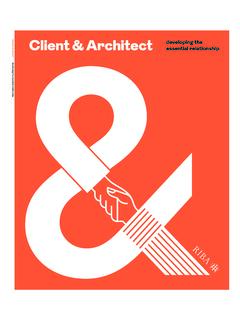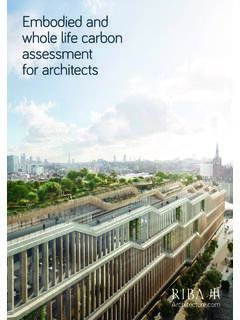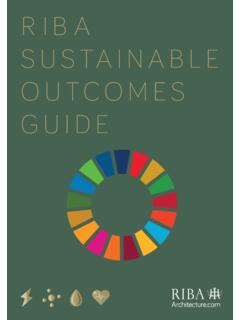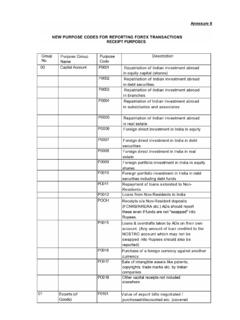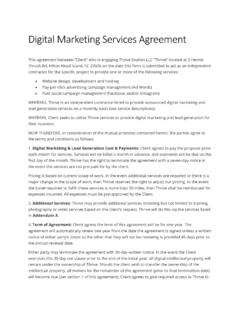Transcription of Ethics in Architectural Practice Case Studies
1 IEthics inArchitectural Practiceii1 Following the publication of the UN Sustainable Development Goals in Practice , earlier in 2017 and the creation of the RIBA Ethics and Sustainable Development Commission (approved by Council in July 2017), the RIBA has undertaken three case Studies which look at the idea of ethical Practice within the Architectural aim of these case Studies is to explore how Ethics features in current Architectural Practice , to highlight some of the ethical issues facing the profession and to provoke debate with a view to sharing information and RowlandsHead of Professional Standards, RIBAF oreword Red Deer2 AECOMMULTI-NATIONAL, MULTI-DISCIPLINARY DEFINABLE Architectural Practice WHICH IS A KEY ACCOUNT RIBA CHARTERED PRACTICEINTERVIEW WITH JENNIFER DIXON, EMIA (EUROPE, THE MIDDLE EAST, INDIA AND AFRICA ARCHITECTURE LEADER2 Hufton+Crow3 ABOUT AECOMAECOM is essentially an engineering design firm , bringing together the collective expertise of architects.)
2 Engineers, designers, planners, surveyors, scientists and project management professionals. It serves clients in more than 150 countries worldwide in markets such as: transportation, facilities, energy, the environment, water, and oil and gas. Of the 85,000+ employees worldwide, approximately 1500 operate as architects on a day-to-day basis. Nearly 500 of these architects Practice in EMIA, under Jennifer Dixon s professional leadership. WHAT ETHICAL Practice MEANS TO AECOMIn its own words, the history of AECOM is a group of employees working in the built environment who shared a dream of creating an industry-leading firm dedicated to making the world a better place . Now that the company has evolved into a [G]lobal network of experts , that vision has crystallized into a commitment to unlock opportunities, protect our environment and improve people s lives.
3 AECOM s view is that built environment professionals generally, and architects in particular, are in a position always to secure a better outcome; indeed, they have a responsibility to do so. Becoming an RIBA Chartered Practice in April 2017 was seen as an important underwriting of the quality and integrity of the product AECOM s architects offer to the end-user as well as the client, a product that withstands scrutiny in an international ETHICAL Practice THROUGH CHANGEAECOM s past commitment to ethical outcomes has been demonstrated over the course of the four consecutive years that the influential Ethisphere Institute rated the Practice as one of the world s most ethical companies. Radical changes to the Practice have occurred since, including the appointment of a new CEO in 2014 and the acquisition of URS Corporation.
4 That period of change is ongoing, with all units of AECOM currently being integrated internationally and professionally, a root-and-branch re-building, and the setting of a consistent culture and standards. AECOM s relatively young Architectural Practice in EMIA has gained maturity from the company s other areas of operation and specialism, transforming it from a small unit (with a focus on sports stadia and projects in Madrid and the UAE) to a comprehensive and truly global Architectural service, delivering high performance buildings, large infrastructure projects and resilient communities. As the A in AECOM grows, there is an opportunity for it both to influence and be influenced by the Ethics of the organisation as a the root-and-branch re-building of the Practice is the ambition of AECOM s CEO, Mike Burke, to make this global company the single best provider of a fully integrated Design, Build, Finance and Operate offer with the interests of the client and the professions, including architecture, firmly in THE PROFESSION TO THRIVEA lthough the Architectural Practice has taken on AECOM s new culture and consistency, it retains a sense of ethical responsibility to support the profession as a whole.
5 As a means of enabling the profession to thrive, AECOM promote the broad role of the architect, as lead designer and co-ordinator, to clients and architects alike. Core to the current day master builder role is an evidence-based approach including accurate reporting and reliable execution; avoiding over-selling and AND TRANSPARENT CLIENT INTERACTIONST here is a natural tension when a large multi-national and multi-disciplinary enterprise seeks to provide a bespoke service to clients. AECOM s Architectural Practice , like the rest of the company, cannot rely on the more traditional methods of fostering good relationships with clients. Personal relationships with clients and other practices based on private understanding and recommendations which smaller Architectural practices may take for granted are potentially open to being misconstrued by other stakeholders within the industry and must be avoided.
6 It is for this reason that AECOM emphasises the need for every decision on any project to demonstrate integrity to be as objective as possible, based on facts and figures, and able to stand up to scrutiny. Accountable decision-making is: for the benefit of clients who know that the professional advice and representations being given are reliable, for the benefit of fellow architects who can work with AECOM 4in an open and transparent manner, and for the benefit of AECOM as a business gaining a strong and respected reputation in the DECISION-MAKINGThe driving force behind the transformation is a move from basing ways of working and reputation on anecdotal evidence, story-telling and general brand awareness to data-driven decision-making, and reliable and accurate reporting.
7 It is essentially a shift away from a subjective approach based on past relationships and recommendations. This is demonstrated most clearly in the process for procuring the teams of architects that will design and deliver a large proportion of the projects AECOM leads. In the past, the more subjective approach resulted in a limited pool of architects and contractors, lacking in diversity, as well as risking exposure to kickbacks, bias and favouritism. AECOM s procurement team is now pioneering a rigorous evaluation system whereby AECOM s architects (as expert procurers ), advise engineers and quantity surveyors throughout the procurement process. Selection for any given project is based on objective criteria, and clearly defined roles and responsibilities, supported by the use of databases, scorecards, industry surveys and other hard information.
8 The only subjective part of the procurement process is a detailed and more targeted interview, focused on the technical capabilities of the architects in question in relation to key elements of individual projects, such as their commitment to digital transformation. The starting point is selecting architects who are right for the project and who will secure a better outcome; the broader aim is for the project to secure the best, most fair, ethical and reliable outcomes for all applies a system of Ethics which, where possible, takes personal involvement out of decision-making and instead relies on objective information to advise clients and procure sub-consultants, for example. EMBEDDING ETHICAL BEHAVIOUR THROUGH FORMAL POLICIES AND TRAININGE thics are embedded in this transformation through comprehensive written standards a Global Ethical Business Conduct Policy and Code of Conduct.
9 This comprises behavioural requirements alongside compulsory leadership training and testing on ethical conduct, involving practical scenarios and dilemmas facing construction industry professionals, which is challenging, thorough and difficult to pass first time! The values in AECOM s Code of Conduct call on their architects to inspire , to anticipate and to dream while also focusing on the need to safeguard . More than aspirational words, these calls to action go to the heart of the manner in which AECOM operates as an employer. This includes its management of balanced working hours, the offer of competitively paid internships, an extensive mentoring programme (focusing on equality, diversity and inclusion) and its creation of psychologically safe spaces for employees to raise and discuss seeks adherence to certain behaviours through rigorously worded policies and ethical conduct training.
10 This is supported by AECOM s employee appraisal process, introduced by the new CEO in 2015, which places at least an equal focus on behaviour and values as on performance. Focusing on key behaviours has already seen dramatic results. Engaging formerly low scoring employees with clearly articulated expectations at each career grade has transformed them into high scorers , for performance as well as behaviours. This has contributed to the continued success of the company and a stable the small details, such as setting up an Ethics hotline, to the big picture including becoming a signatory of the UN Global Compact AECOM s Architectural Practice has a clear ethos and a clear plan: supporting its employees, setting high industry standards and supporting and promoting the Architectural profession as a whole in order to secure better outcomes for AND CHALLENGESAECOM applies a system of Ethics which takes subjectivity out of procurement decision-making and seeks to establish certain behaviours through policies and training.
